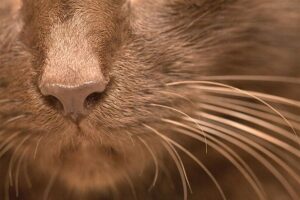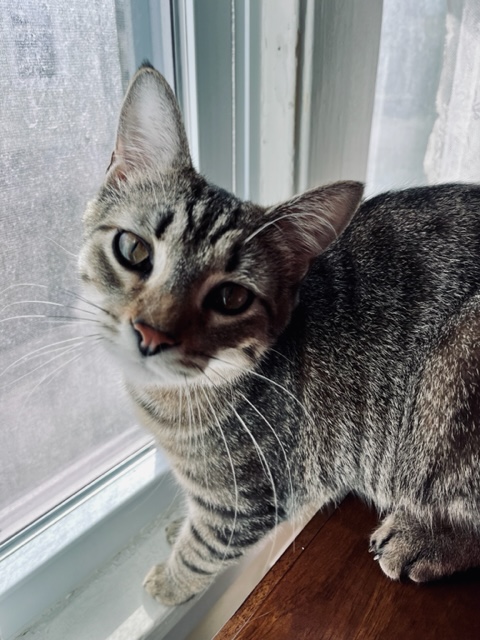Why would a white cat have black or partially black whiskers? And why would a black cat have white whiskers? It turns out whisker color varies for a few reasons, and they can even be striped! Read on for more information on whisker color and its origin.

I became interested in the question of whisker pigment when I noticed my tabby cat Toby had whiskers that were black closer to his face but white on the ends. I initially was worried about his health! So, after a deep dive I’ve learned a few things about cat whisker color.
Black, White and Banded Whiskers
First, it turns out that having both colors on a single whisker is known as banding and is associated with the agouti gene in cats. It’s also associated with ticked coats, seen in many tabbies and Abyssinian cats. It is NOT associated with any health problems.
Second, it appears that “Most, if not nearly all felines of all sizes, do appear to have white whiskers,” says internationally renowned researcher Frank Rice of Albany Medical College. This is typically because cat whiskers are thick, and do not usually retain any melanin. However, both black and white whiskers are both are healthy, normal colors.
Whisker Formation
When a whisker forms, it starts out as a single ring of skin cells at the root. Then, a new ring forms and pushes that first ring up, and then yet another forms below those and pushes them up, over and over again until ring by ring, a whisker is formed. As new cells push the cone that forms the whisker upwards, the tissue around the cone squeezes it and the skin cells die. These dead, compressed skin cells form the whisker, which is usually white because the cells lose pigment as they rise up to the surface. But sometimes, and especially closer to the face, the whisker retains some melanin and can be dark (like my boy Toby’s!)
Age and Genetics
Whiskers can also lighten and darken with age. In fact, there seems to be a variety in whisker color (whether black, white or banded) just like the variety in fur color- this is likely linked to genetics. For example, the Bombay breed of cat has black whiskers throughout their life. And some cats age but always keep white whiskers.

So, it is clear that whiskers can be black, white or banded and for a few different reasons. But the important thing is that none of the colors have to do with health problems in any way!
Sources:
https://www.theglobeandmail.com/technology/why-most-cats-whiskers-are-white/article4275677/

Leave a Reply